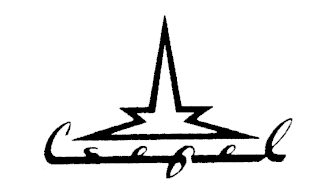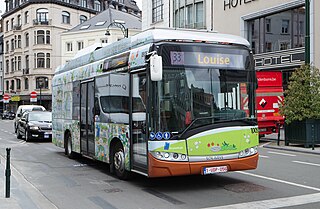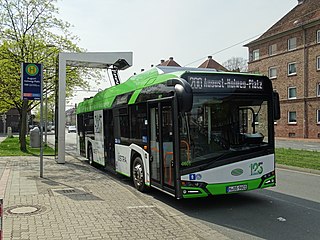Air suspension is a type of vehicle suspension powered by an electric or engine-driven air pump or compressor. This compressor pumps the air into a flexible bellows, usually made from textile-reinforced rubber. Unlike hydropneumatic suspension, which offers many similar features, air suspension does not use pressurized liquid, but pressurized air. The air pressure inflates the bellows, and raises the chassis from the axle.

A midibus is a classification of single-decker minibuses which are generally larger than a traditional minibus but smaller than a full-size single decker and can be anywhere between 8 metres and 11 metres long. While used in many parts of the world, the midibus is perhaps most common in the United Kingdom, where operators have found them more economical, and to have a sufficient number of seats compared to full size single-decker buses.

Autosan Sp. z o.o. is a Polish bus and coach manufacturer. The company is located in Sanok, Poland. Its sales network includes European, African and Asian countries. Currently it produces approximately 300 buses a year.

The Bristol VR was a rear-engined double-decker bus chassis which was manufactured by Bristol Commercial Vehicles as a competitor to the Leyland Atlantean and Daimler Fleetline.

A vehicle frame, also historically known as its chassis, is the main supporting structure of a motor vehicle to which all other components are attached, comparable to the skeleton of an organism.

Karosa was a bus manufacturer in Vysoké Mýto in the Czech Republic. It was the biggest manufacturer of buses in Czechoslovakia. In 2007 its name was changed to Iveco Czech Republic, and now the company produces buses under the name Iveco Bus.

Sanos is a company from Skopje, North Macedonia, which produces urban, suburban and intercity buses, airport buses and special vehicles.

The Ford Transit Bus was a medium-duty transit bus produced by Ford from 1936 to 1947. The engine was originally placed at the front, but a rear-engine version replaced the original design in 1939. Ford constructed the chassis, which were then fitted with bodies constructed by the Union City Body Company of Union City, Indiana. Canadian versions were built from chassis fabricated in Windsor and bodies produced by Brantford Coach & Body, from 1941 to 1943.

Csepel was a Hungarian manufacturer of trucks for industrial use.

The RÁBA Automotive Group, commonly known as Rába, is a Hungarian public limited company, listed on the Budapest Stock Exchange. Rába engineers, manufactures and customizes automotive components, specialty vehicles and axles for commercial vehicles, agri-machinery and earth-movers. The Rába has been building axles as well as complete vehicles since 1902. The company has three strategic business units. The company is headquartered in Győr, employing more than 2000 people.

Jelcz M11 is a Polish step entrance city bus manufactured by Jelczańskie Zakłady Samochodowe in Jelcz-Laskowice near Oława. It was manufactured from 1985 until 1990. From constructional side it was a hybrid made from modified body chassis of Jelcz PR110 and frame and drivetrain of Ikarus 260. During its production there were no significant changes to the construction of the bus.

The Solaris Urbino 10 is the 10-metre variant of the Solaris Urbino line of low-floor buses. It has been produced since 2002 by the Polish company Solaris Bus & Coach in Bolechowo near Poznań.

The Jelcz PR110D is a coach and intercity bus produced by the Polish company Jelcz in Jelcz-Laskowice near Oława in Poland in 1984-1992.

Solaris Urbino 8,9 LE electric is a low-entry electric city bus, that debuted in autumn 2011. It was produced by the company Solaris Bus & Coach S.A. from Bolechowo near Poznań. Its design is based on the Solaris Urbino 8,9 LE. It was the first electric bus manufactured in Poland. In Poland, it is in use in Ostrołęka, Cracow, Jaworzno, Ciechanow, Chodzież, Września, Katowice and Stalowa Wola.

Solaris Vacanza is a tourist coach that was produced between 2001 and 2010 by Solaris Bus & Coach. Two models were offered - the two-axle Solaris Vacanza 12 and the three-axle Solaris Vacanza 13. The Vacanza was replaced in 2010 by the Solaris InterUrbino.

Solaris Valletta is a commercial name for the Solaris Urbino 11,001 bus. The bus was produced by the Polish company Solaris Bus & Coach in Bolechowo near Poznań in two versions, as a bus for the suburban or interurban public transportation system. A total of four units were built.

The Autosan Wetlina is a minibus built on the chassis of the Mercedes-Benz Vario O818D, that was produced between 2008 and 2013.

SOR NB18 is a low-floor articulated single-decker bus produced by bus manufacturer SOR from the Czech Republic since 2008. Since 2009 bus also comes with hybrid drive SOR NBH 18. In many towns they currently replace Karosa B 741 and Karosa B 941.

The Solaris Urbino 12 electric is an electric version of the Solaris Urbino 12 low-floor transit bus series first unveiled in 2012. It has been in production since 2013, and in 2016, it was awarded the title of Bus of the Year 2017.

Stanisław Panczakiewicz was a pioneering Polish car body designer and engineer.




















